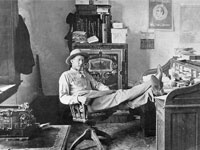A Brief History of Prescott

 Prescott, Arizona, did not exist when President Lincoln signed the bill that separated New Mexico from Arizona in 1863. Lincoln no doubt was familiar with the historian William Hickling Prescott, whose books on Mexico and Peru made the nearly blind Bostonian the David McCullogh of his day. Lincoln did know that any capital for the newly established Arizona territory would be located far from Confederate sympathizers in Tucson.
Prescott, Arizona, did not exist when President Lincoln signed the bill that separated New Mexico from Arizona in 1863. Lincoln no doubt was familiar with the historian William Hickling Prescott, whose books on Mexico and Peru made the nearly blind Bostonian the David McCullogh of his day. Lincoln did know that any capital for the newly established Arizona territory would be located far from Confederate sympathizers in Tucson.
With the discovery of gold that same year near the headwaters of the Hassayampa River by Joseph Walker and his men, it became strategic to locate the territorial capital in the Bradshaw Mountains, near that wealth. The Civil War was raging, and any western resources could help secure a Union victory. The first presidential appointee as territorial governor of Arizona, John Gurley of Ohio, died in August of 1863, before the delegation left for the west. John Goodwin of Maine succeeded Gurley.
Traveling by train, riverboat, and then by horseback over the Santa Fe Trail, the official party arrived at Navajo Springs, between the Puerco and Little Colorado rivers, just across the New Mexico line, in late December of 1863. On December 29, Richard McCormick of New York, the Secretary to the Territory, raised the U.S. flag and administered the oath of office to Governor Goodwin.
After a few months of military garrison at Del Rio Springs in Chino Valley, the official party, and the military headquarters, relocated 20 miles to the south, along the banks of Granite Creek, in an open, park-like setting of mature ponderosa pines and sheltering ridges.
During the fall of 1864, construction was being completed on many buildings of Fort Whipple, and on the Territorial Governor’s Mansion, still in its same location at the center of the Sharlot Hall Museum campus. In late May or early June of 1864, Prescott became the formal name of the territorial capital. Secretary McCormick brought a sizable library to the territory, including W. H. Prescott’s best seller, “The Conquest of Mexico,” in which was proposed an origin of Aztecs and Toltecs in the region of Prescott. The many ancient ruins were thought to have an Aztec connection.
While the territorial government and the new residents of Prescott were glorifying a nonexistent native people, they were simultaneously driving from the land the actual native people, the Yavapai. Settlers, miners, and ranchers all complained about the “Indian troubles.” The perspective that the Yavapai might be having “Euro-American troubles” would have been foreign to the dominant newcomers. Ten years after the founding of Prescott, in February of 1875, all Yavapai were forcibly moved to the southeastern part of the territory, near San Carlos, where they lived alongside the Apache for 20 years.
Upon their return in the early 1900s, the Yavapai lived in poverty, working as ranch hands or maids, confined to a small area near Fort Whipple, which became their reservation in 1935.
The period 1890-1920 may have been the most dynamic in Prescott’s history. The town square, Courthouse Plaza, surveyed by Robert Groom in 1864, was now the busy center of business and pleasure. Major retail outlets, such as the Bashford-Burmister Company and the mercantile enterprise of the Goldwater’s, were going strong. The first courthouse was settling criminal cases, sometimes with a hanging on the square.
The stretch of Montezuma Street along the western side of Courthouse Plaza was becoming known as Whiskey Row, due to the many saloons where a glass of “old popskull” could be had. The Row burned to the ground on July 14, 1900, but was quickly rebuilt. One famous gambler, Sheriff William “Buckey” O’Neill, did not witness the fire; he had been dead for two years, one of the Rough Rider casualties in Cuba. Behind Whiskey Row were the Chinese and brothel districts. One two-story bordello was on the site of today’s modern parking garage. Chinatown was centered along Granite Street, adjacent to Granite Creek. As many as 500 Chinese immigrants passed through Prescott between 1870 and 1930, many of them returning to China with a hard-earned prosperity from their labors as gardeners, laundry workers, and restaurant owners.
If you were roaming the downtown area of Prescott in the early years, and looking for more refined entertainment than hard drink, prostitutes, or opium dens, you would find such elegance at the Elks Opera House, built in 1905 and still in operation. By 1920, Fort Whipple had ceased to be a military facility, and had been transformed into a medical facility to treat the many victims of gas warfare in the trenches of Europe. In 1930, two more historic institutions had been added to the downtown area.
The Hassayampa Inn opened for business in 1927, and Sharlot M. Hall opened her museum in the aforementioned Territorial Governor’s Mansion in 1928. Sharlot Mabridth Hall arrived in Prescott by covered wagon in 1882 at the age of 12, after three months of hard travel along the old Santa Fe Trail. Hall was a writer and poet from an early age, and helped support her family with articles and poems about the West. Her first volume of verse, Cactus and Pine, was published two years after she was appointed Territorial Historian in 1909 (the first Arizona woman to hold territorial office). She was also an associate editor of Out West magazine.
Hall was a forward-thinking woman of vision and daring, living during an era when most women didn’t dare have any vision at all. She developed an intense fascination and love for Arizona and southwestern frontier life and history, and sought to conserve what she understood to be its vanishing heritage and traditions.
 In 1924, as an elected delegate to the electoral college in Washington D.C., she toured many private and public museums in the East, and returned to Prescott determined to preserve Arizona’s pioneer and Native American history for subsequent generations. She secured a lease on the grounds where the first Territorial Governor’s Mansion stood, restored the building, and began gathering and preserving artifacts. The Sharlot Hall Museum stands today as a testament to this remarkable pioneer’s foresight and determination. (Learn more about the Sharlot Hall Museum in the Attractions & Lodging section of this magazine.)
In 1924, as an elected delegate to the electoral college in Washington D.C., she toured many private and public museums in the East, and returned to Prescott determined to preserve Arizona’s pioneer and Native American history for subsequent generations. She secured a lease on the grounds where the first Territorial Governor’s Mansion stood, restored the building, and began gathering and preserving artifacts. The Sharlot Hall Museum stands today as a testament to this remarkable pioneer’s foresight and determination. (Learn more about the Sharlot Hall Museum in the Attractions & Lodging section of this magazine.)
- In 1985, Arizona Highways magazine proclaimed Prescott “Everybody’s Hometown”
- Virgil Earp, Wyatt Earp’s brother, ran a sawmill in Prescott in the mid-1800s
- Movie star Tom Mix appeared in several movies that showcased Prescott’s scenic mountains
- In 1863, the first 73 lots in downtown Prescott sold for an average of $53.50 per lot
- Prescott was the capital of Arizona from 1864 to 1867, and again from 1877 to 1887
- The fire of 1900 nearly destroyed all businesses in downtown Prescott
- Prescott is home to The Words Oldest Rodeo
- Lynx Creek was the richest stream bed in Arizona, yielding $2 million in gold
Interesting Facts about Prescott
Information above is Courtesy Prescott Chamber of Commerce


